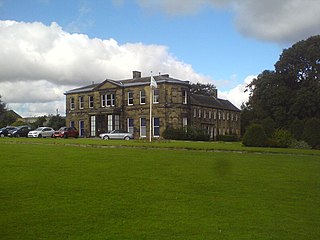
Farnley Hall is a stately home in Farnley, west Leeds, West Yorkshire, England. It is a grade II listed building. It was built in Elizabethan times by the Danbys. The manor is recorded in the 1086 Domesday Book as Fernelei, so it is probable that this house was a replacement for earlier medieval structures.
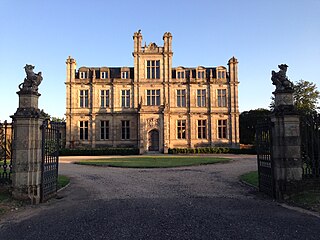
Bylaugh Hall, also known as Bylaugh Park, is a country house situated in the parish of Bylaugh in Norfolk, England.

Alfreton Hall is a country house in Alfreton, Derbyshire. It was at the heart of local social and industrial history in the county. The history of the estate goes back to Norman times, but by the 17th century it was owned by the Morewood family, who were linked to local industry, mainly in coal mining.
This is a list of the High Sheriffs of County Durham, England.

Brocton Hall is a building of historical significance and is listed on the English Heritage Register. It was built in 1760 by William Chetwynd and remained in the Chetwynd family until 1923 when it was sold to the Golf Club. Today the building is still used as a clubhouse and is also a venue for weddings.
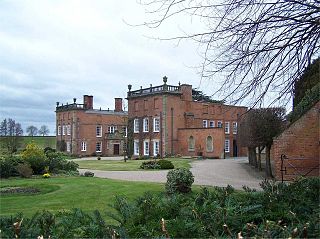
Longford Hall is a 16th-century country house at Longford in the Dales district of Derbyshire, England. It is a Grade II* listed building.
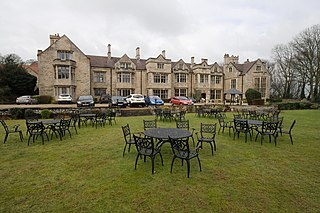
Redworth Hall is a 17th-century country house at Redworth, Heighington, County Durham, England now converted to a hotel. It is a listed building.

Beamish Hall is a mid-18th-century country house, now converted to a hotel, which stands in 24 acres (97,000 m2) of grounds near the town of Stanley, County Durham. It is a Grade II* listed building.
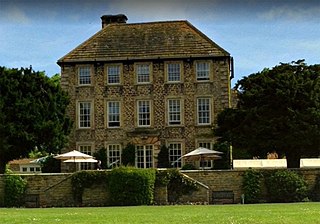
Headlam Hall is a 17th-century country house at The Green, Headlam, near Gainford, County Durham, England. It is a Grade II* listed building now in use as a hotel and country club.

Middlewich Manor is a former manor house in Middlewich, Cheshire, England. It was originally constructed in brick in about 1800, and it was encased in ashlar in about 1840, when the porch was also built The bay windows were added in the 1870s. As of 2011, it is a residential care home. The house is constructed in yellow ashlar and is in two storeys. On its entrance front is a porch supported by four fluted Ionic columns. Along the top of the porch is a frieze and a cornice. On each side of the porch are two-storey canted bay windows. Between the stories is a band of Greek keys. A parapet runs along the top of the house, behind which is a low-pitched roof. On the garden front there are sash windows and a canted two-storey bay window to the right, and a wing with a stone oriel window and a pyramidal slated roof to the left. There is more decoration with bands of Greek keys on this front. The house is recorded in the National Heritage List for England as a designated Grade II listed building.

Trafford Hall is an 18th-century country house standing to the east of the village of Wimbolds Trafford in Cheshire, England, about 4+1⁄2 miles (7 km) northeast of the city of Chester. It is owned by The Regenda Group and operated as a youth hostel and training centre by the Youth Hostels Association.

Isel Hall is an ancient Cumbrian residence that sits on a steep rise on the northern banks of the River Derwent, two miles (3.2 km) south of Bassenthwaite Lake, three miles (4.8 km) east-north-east of Cockermouth, with views over the Lake District fells and Skiddaw. It was once the home of the Lawson family and is a Grade I listed building.

Narborough Hall is a Grade II* listed building in Narborough in Leicestershire. Believed to date from 1596 this Elizabethan manor house was built by James Meade, a local landowner. However, it was only after it was extensively remodelled in the mid-19th century that it became known as Narborough Hall. It is notable because of its construction from local pink granite.

Hardwick Hall in Sedgefield, County Durham is a building of historical significance and is listed on the English Heritage Register. A major part of it was built in the late 1700s but it is possible that some of it dates from about 1634. It was the residence for many notable people for two centuries. It is now a hotel which provides accommodation and restaurant services and caters for special events particularly weddings.

Harleyford Manor is a country house near Marlow in Buckinghamshire.

Cuffern Manor in Roch, Pembrokeshire is a house of historical significance and is listed on the Wales Heritage Register. It was built in 1770 by John Rees Stokes shortly after he inherited a fortune from his cousin. It remained in the Stokes family for the next 150 years. Today it provides bed and breakfast accommodation and caters for special events, particularly weddings.

Malling House is a 17th-century country house in Lewes, East Sussex, England. It is a Grade I listed building and serves as the headquarters of Sussex Police.

Stanley House in Mellor, Lancashire, England, is a building of historical significance and is Grade II* listed on the English Heritage Register. It was built in the late 16th or early 17th century and was the home of notable people for many years. However, by the early 19th century, the status of the house sank to that of a rented farmhouse. Farming activity continued over the next two centuries with tenant farmers being the occupants. In 1999 the land and buildings were then purchased by Leehand Leisure Ltd, and they converted the building to a hotel and spa which opened in 2003.






















